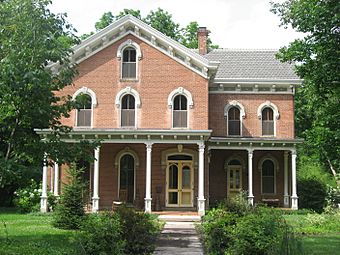Yellow Springs Historic District facts for kids
Quick facts for kids |
|
|
Yellow Springs Historic District
|
|

A typical house in the district
|
|
| Location | Roughly bounded by RR tracks, Yellow Springs-Fairfield Rd., High and Herman Sts., Yellow Springs, Ohio |
|---|---|
| Area | 460.5 acres (186.4 ha) |
| Architectural style | Greek Revival, Italianate, Federal |
| NRHP reference No. | 82003573 |
| Added to NRHP | April 1, 1982 |
The Yellow Springs Historic District is a special area in the village of Yellow Springs, Ohio, United States. It's like a big outdoor museum that includes most of the village. This district helps protect many old and important buildings.
Contents
Yellow Springs Historic District
How Yellow Springs Grew
Yellow Springs started to grow in the 1840s. Before 1846, it was just a church and a few houses. But a special mineral spring in Glen Helen started to attract people. They believed the spring's water could help them feel better.
In 1846, a store was built, and the Little Miami Railroad came through. These new additions helped the community grow quickly. Even though the land wasn't officially mapped out yet, more people started to move there.
The main part of the village slowly moved west. It settled on the hills near the railroad tracks and the spring. As more brick houses were built, Yellow Springs began to look like a real town. The village was officially mapped in 1853. All the buildings that are still standing today were built in 1853 or later.
Antioch College was started in 1852. The people of Yellow Springs promised money and free land for the college. The college leaders accepted their offer. The first buildings, called Antioch, North, and South Halls, were finished in late 1853.
By 1856, Yellow Springs was doing very well. Many of its buildings show the popular architectural styles from that time. But after the American Civil War, growth slowed down.
For example, the Neff House was a big hotel built in 1840. It served visitors from Cincinnati and Columbus who came for the springs. The hotel burned down during the war. The owner rebuilt it in 1870. The new building was huge, with more rooms than all other hotels in Greene County combined! But by 1890, business dropped a lot. The owner had the hotel taken apart and moved to Cincinnati in 1892.
What Happened Next?
Old Buildings and Styles
Today, many buildings in Yellow Springs show the Federal or Greek Revival styles. There are also many everyday buildings, like I-houses. These are simple, traditional homes.
Most of the shops and businesses were built after the town's busiest period. This means they have a mix of different styles.
Protecting History
In 1982, the Yellow Springs Historic District was officially recognized. It was added to the National Register of Historic Places. This happened because of its important history and its old buildings.
The district covers most of the village. It starts at the railroad tracks and goes several blocks west. It includes both sides of U.S. Route 68 and a large part of the Antioch College campus.
There are 473 buildings in the district. In 1982, 261 of these buildings were considered "contributing properties." This means they added to the historic feel of the district. The other 212 buildings were "non-contributing."
The Antioch, North, and South Halls on the college campus are part of the district. They are also listed separately on the National Register. However, another historic building, the South School, is not part of this district.



